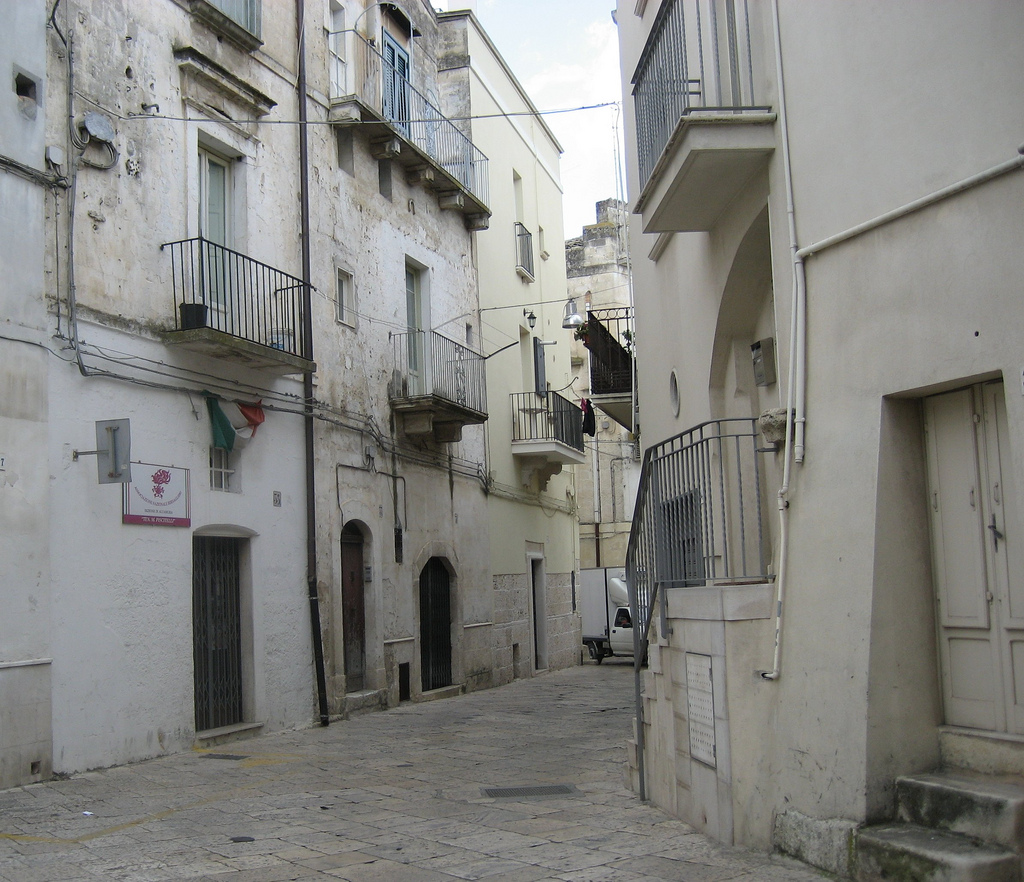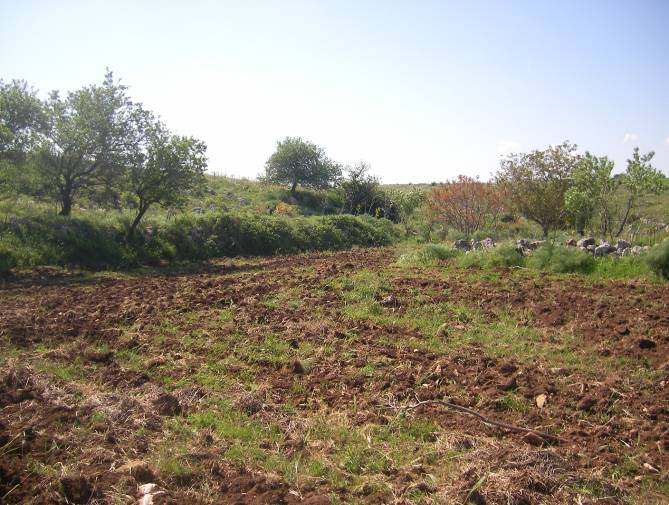|
Pulicchio Di Gravina
Pulicchio di Gravina (in the local dialect ''Pulícchie'' or ''Pulidde'') is the second-largest doline in the Murge plateau (in Apulia, southern Italy) after Pulo di Altamura. It falls into the territory of Gravina in Puglia, being located about north of the latter, close to the border with Altamura's territory. It shares the local toponym ''pulo'' with other large dolines of the region, i.e. Pulo di Altamura, Pulo di Molfetta and Pulicchio di Toritto. The doline is very close to other two karst landforms, Gurio Lamanna and Tre Paduli. Dimensions The doline is shaped like an egg and it is highly regular, with the slope almost constant on all its sides (as shown on the map's level curves). The biggest length (in direction NNW-SE) is equal to . The doline is somewhat wider in the northern part () than in the southern part (). Its perimeter is approximately , while the maximum depth is . The lowest point has height from the sea level. Therefore, the doline turns out to be ... [...More Info...] [...Related Items...] OR: [Wikipedia] [Google] [Baidu] |
Altamura
Altamura (, ; nap, label= Barese, Ialtamùre) is a town and ''comune'' of Apulia, in southern Italy. It is located on one of the hills of the Murge plateau in the Metropolitan City of Bari, southwest of Bari, close to the border with Basilicata. , its population amounts to 70,595 inhabitants. The city is known for its particular quality of bread called Pane di Altamura, which is sold in numerous other Italian cities. The 130,000-year-old calcified Altamura Man was discovered in 1993 in the nearby limestone cave called ''grotta di Lamalunga''. History The area of modern Altamura was densely inhabited in the Bronze Age (La Croce settlement and necropolis). The region contains some fifty tumuli. Between the 6th and the 3rd century BC a massive line of megalithic walls was erected, traces of which are still visible in some areas of the city. Ancient city The city was inhabited until around the tenth century AD. Then it was reportedly looted by Saracens. There are no reliable ... [...More Info...] [...Related Items...] OR: [Wikipedia] [Google] [Baidu] |
Lama (geology)
Lama is a local toponym that denotes a wide furrow in the ground typical of the Murge landscape. Lamas convey rainwater from the Murge plateau to the endpoint of the drainage basin they belong to. Lamas are generally confused with rivers or streams. There is a big difference between lamas and streams, since lamas collect only rainwater of their drainage basin, while they are completely dry when there is no rain. Moreover, in lamas water mostly flows underground and just a small amount of the rainwater flows on its surface. As for lamas, surface runoff is greatest in the extreme and uncommon situations of heavy rain. Lamas usually contain fertile soil, that deposited over the millennia due to the erosion and they are usually cultivated. Since they contain fertile soil, they are distinguishable from the nearby typical area of the Murge plateau, that is almost everywhere stony, arid and hard to grow. Lamas also occur in proximity of such notable dolines as Pulo di Altamura, Gurio L ... [...More Info...] [...Related Items...] OR: [Wikipedia] [Google] [Baidu] |
Lama (geology)
Lama is a local toponym that denotes a wide furrow in the ground typical of the Murge landscape. Lamas convey rainwater from the Murge plateau to the endpoint of the drainage basin they belong to. Lamas are generally confused with rivers or streams. There is a big difference between lamas and streams, since lamas collect only rainwater of their drainage basin, while they are completely dry when there is no rain. Moreover, in lamas water mostly flows underground and just a small amount of the rainwater flows on its surface. As for lamas, surface runoff is greatest in the extreme and uncommon situations of heavy rain. Lamas usually contain fertile soil, that deposited over the millennia due to the erosion and they are usually cultivated. Since they contain fertile soil, they are distinguishable from the nearby typical area of the Murge plateau, that is almost everywhere stony, arid and hard to grow. Lamas also occur in proximity of such notable dolines as Pulo di Altamura, Gurio L ... [...More Info...] [...Related Items...] OR: [Wikipedia] [Google] [Baidu] |
Sinkholes
A sinkhole is a depression or hole in the ground caused by some form of collapse of the surface layer. The term is sometimes used to refer to doline, enclosed depressions that are locally also known as ''vrtače'' and shakeholes, and to openings where surface water enters into underground passages known as ''ponor'', swallow hole or swallet. A ''cenote'' is a type of sinkhole that exposes groundwater underneath. A ''sink'' or ''stream sink'' are more general terms for sites that drain surface water, possibly by infiltration into sediment or crumbled rock. Most sinkholes are caused by karst processes – the chemical dissolution of carbonate rocks, collapse or suffosion processes. Sinkholes are usually circular and vary in size from tens to hundreds of meters both in diameter and depth, and vary in form from soil-lined bowls to bedrock-edged chasms. Sinkholes may form gradually or suddenly, and are found worldwide. Formation Natural processes Sinkholes may capture surf ... [...More Info...] [...Related Items...] OR: [Wikipedia] [Google] [Baidu] |
Drainage Basin
A drainage basin is an area of land where all flowing surface water converges to a single point, such as a river mouth, or flows into another body of water, such as a lake or ocean. A basin is separated from adjacent basins by a perimeter, the '' drainage divide'', made up of a succession of elevated features, such as ridges and hills. A basin may consist of smaller basins that merge at river confluences, forming a hierarchical pattern. Other terms for a drainage basin are catchment area, catchment basin, drainage area, river basin, water basin, and impluvium. In North America, they are commonly called a watershed, though in other English-speaking places, "watershed" is used only in its original sense, that of a drainage divide. In a closed drainage basin, or endorheic basin, the water converges to a single point inside the basin, known as a sink, which may be a permanent lake, a dry lake, or a point where surface water is lost underground. Drainage basins are similar ... [...More Info...] [...Related Items...] OR: [Wikipedia] [Google] [Baidu] |
Subsidence
Subsidence is a general term for downward vertical movement of the Earth's surface, which can be caused by both natural processes and human activities. Subsidence involves little or no horizontal movement, which distinguishes it from slope movement. Processes that lead to subsidence include dissolution of underlying carbonate rock by groundwater; gradual compaction of sediments; withdrawal of fluid lava from beneath a solidified crust of rock; mining; pumping of subsurface fluids, such as groundwater or petroleum; or warping of the Earth's crust by tectonic forces. Subsidence resulting from tectonic deformation of the crust is known as tectonic subsidence and can create accommodation for sediments to accumulate and eventually lithify into sedimentary rock. Ground subsidence is of global concern to geologists, geotechnical engineers, surveyors, engineers, urban planners, landowners, and the public in general.National Research Council, 1991. ''Mitigating losses from land subsi ... [...More Info...] [...Related Items...] OR: [Wikipedia] [Google] [Baidu] |
Carmelo Colamonico
Vito Carmelo Colamonico (27 July 1882 – 31 December 1973) was an Italian ''geographer'', ''geologist'' and scholar. His works include studies on some karst dolines and landforms of Italy, such as Pulo di Altamura, Pulicchio di Gravina and Gurio Lamanna. Biography Carmelo Colamonico was born in Acquaviva delle Fonti, in the historic city center, near the church of Sant'Agostino. He attended the classical lyceum in Gioia del Colle, with historian Antonio Lucarelli as a literature teacher. He graduated in Italian literature at the University of Naples in 1905 with a dissertation on Apulia's geography. During his university years, he became an assistant to Professor Filippo Porena, one of the most prominent geographers at that time, who encouraged him because of his intelligence. Returned from Naples, he actively participated in the social and political life of the town, becoming a councilor for public education. He taught in the classical lyceum of Gioia del Colle and some ... [...More Info...] [...Related Items...] OR: [Wikipedia] [Google] [Baidu] |
Geologists
A geologist is a scientist who studies the solid, liquid, and gaseous matter that constitutes Earth and other terrestrial planets, as well as the processes that shape them. Geologists usually study geology, earth science, or geophysics, although backgrounds in physics, chemistry, biology, and other sciences are also useful. Field research (field work) is an important component of geology, although many subdisciplines incorporate laboratory and digitalized work. Geologists can be classified in a larger group of scientists, called geoscientists. Geologists work in the energy and mining sectors searching for natural resources such as petroleum, natural gas, precious and base metals. They are also in the forefront of preventing and mitigating damage from natural hazards and disasters such as earthquakes, volcanoes, tsunamis and landslides. Their studies are used to warn the general public of the occurrence of these events. Geologists are also important contributors to climate chan ... [...More Info...] [...Related Items...] OR: [Wikipedia] [Google] [Baidu] |



.jpg)

